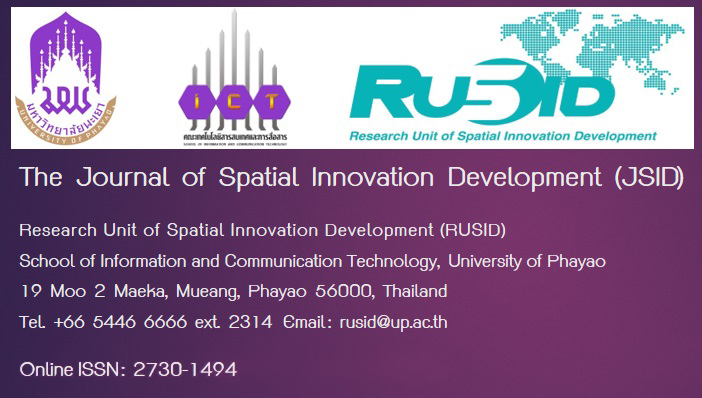A Virtual Reality to Present Sand Stone Buddha Statue of Phayao’s Craftsmen
Keywords:
Sandstone Buddha Statues of Phayao’s Craftsmen, Virtual Reality, PhotogrammetryAbstract
The project involving the virtual reality representation of sandstone Buddha statues crafted by artisans from Phayao holds significant importance within the realm of Buddhist arts. Originating during the Lanna Kingdom, specifically spanning the 19th to the 22nd Buddhist centuries, these statues have garnered distinction as a unique and exceptional form of artistic expression. A testament to the enduring opulence of the Lanna Kingdom, these artifacts continue to resonate in contemporary times. This research endeavors to adopt a novel approach, fusing artistic and methodological elements to unveil its findings. A comprehensive search was undertaken, underpinned by a creative amalgamation of art and research. A compendium of relevant scholarly sources was amassed, shedding light on the sandstone Buddha statues attributed to the skilled craftsmen of Phayao. Subsequently, employing the innovative technique of photogrammetry, By DSLR camera and use the program (Agisoft Matashape) for processing. intricate three-dimensional renditions of the Buddha were meticulously created. These digital representations served as the foundation for the ensuing construction of an immersive virtual reality environment—a platform conceived to be accessible to the broader populace, facilitating their engagement with this cultural heritage. The resultant feedback derived from the assessment of the polygonal 3D models of Phayao artisans' sandstone Buddha statues underscores a pronounced level of satisfaction. The evaluative metrics yielded an impressive satisfaction rating of 4.25— Satisfaction is at a high level. a testament to the profound enjoyment experienced by the participants within this virtual realm.
References
Arbace, L., Sonnino, E., Callieri, M., Dellepiane, M., Fabbri, M., Iaccarino Idelson, A., & Scopigno, R. (2013). Innovative uses of 3D digital technologies to assist the restoration of a fragmented terracotta statue. Journal of cultural heritage, 332-345.
Aryana, M. R., Warsono, S., Achjari, D., & Nahartyo, E. (2022). Virtual reality learning media with innovative learning materials to enhance individual learning outcomes based on cognitive load theory. The international journal of management education, 100657.
Asefi, M., Khasraghi, S. S., & Roders, A. P. (2019). Art and technology interactions in Islamic and Christian context: Historical approach to architectural globalization. Frontiers of Architectural Research, 66-79.
Dozio, N., Marcolin, F., Scurati, G. W., Ulrich, L., Nonis, F., Vezzetti, E., .Ferrise, F. (2022). A design methodology for affective Virtual Reality. International journal of human-computer studies.
Remondino, F. (2011). Heritage Recording and 3D Modeling with Photogrammetry and 3D Scanning. Research Unit, Bruno Kessler Foundation Trento, Italy.
Kim, B. (2016). Virtual Reality as an Artistic Medium: A Study on Creative Projects Using Contemporary Head-Mounted Displays. Helsinki: Department of Media School of Arts, Design and Architecture Aalto University.
Kolay, S. (2016). Cultural heritage preservation of traditional Indian art through virtual new-media. Procedia, social and behavioral sciences, 309-320.
Narut, S., Panu, S., Scurati, G., Preesarn, R. (2017). 3D modeling from multiple images for cultural heritage. Geo-Informatics and Space Technology Development Agency.
Nat, D., Korawat, P., Panida, W., Purim, J. (2014). Development of learning materials Atomic structure and chemical bonding with Augmented Reality technology. Science, Technology and Environment for Learning Research Unit Journal Ubon Ratchathani University, 5(1),21-27.
Pregesbauer, D. (2016). Austria 360°: An Exploratory Study of User Experience on Tourism Virtual Reality Application. Vienna: Modul vienna university.
Rahaman, H., Champion, E., & Bekele, M. (2019). From photo to 3D to mixed reality: A complete workflow for cultural heritage visualisation and experience. Digital applications in archaeology and cultural heritage.
Vosinakis, S., Xenakis, I. (2011). Virrtual World Installation in an Art Exhibition. Conference: Re-Thinking Technology in Museums.
Whyte, J. ( 2002). Virtual Reality and the Built Environment. Oxford: London.
Wiwat, M. (2014). The results of the development of learning materials with augmented reality technology About the group’s national costume Asean Community. Journal of Social Communication Innovation, 2(2), 14-18.





